Textured determines how the facade will look. In order for the surface texture to be special, special materials are used. From these components, the names textured, textured, as well as structural facade paint appeared. The definition depends on what filler is in them.
When textured paints are used to paint a surface, its appearance will be determined not only by the composition of the coloring matter. It will also depend on how the paint was applied, and what specific technological method was used in this case.
Application methods
More often, textured facade paint is applied with a roller in one layer. Spatulas, sponges, combs and "pneumatics" - pneumatic spraying are also used. With one or another method of application, it is spent different amount paint, and this must be taken into account.
facade textured can range from 500 to 1500 g / m2. This is explained by the fact that the thickness of such a layer can reach 10 mm. Such a large thickness allows you to paint walls, pre-cleaning which were not applied. Hides all defects textured paint for facades.
In this case, the paint consumption is large. But, how much time can be saved on the fact that cleaning and puttying of surfaces is not done.
Although the structural facade paint can be applied in thick layers, the vapor permeability remains normal. There are practically no barriers to the natural regulation of humidity. Compared to ordinary facade paints, our paints provide walls with greater resistance to mechanical stress. They are therefore often used for painting surfaces that are subject to high abrasive wear.
Facade textured paint, made on the basis of aqueous acrylic dispersions, has proven itself very well. The negative effect of such compounds on the body is minimal, because they do not contain a volatile organic solvent. Due to this, textured facade paint can be used inside some rooms. Before applying, carefully read the composition of the product.
Textured facade paint can be applied both to completely new and previously painted surfaces. The surface material can be concrete, drywall, brick, wood. Structural facade paint is also applied to the plaster.
Specifications
A surface painted with textured paint will look different with the application of different techniques applying paint. And this requires skill.
To achieve the "bark beetle" effect, a Teflon spatula is used. It is constantly dipped into the water, and the grains of the filler are carefully pulled out to avoid the appearance of grooves.
There are simpler methods of staining. For example, use for coloring structural roller. You don't have to be a professional to use this tool.
Pneumatic spraying is performed when the pressure is set to 4-6 atm. Nozzles with a diameter of 3-6 mm are used. When resorting to this method, care should be taken to ensure that the scaffolding is at a proper distance from the surface to be painted. Thus, it will be possible to prevent the formation of unpainted areas.

As for the structural facade paint, it is recommended to use it in cases where it is necessary to make the treated surface embossed.
Applying textured paint is easy ideal solution in cases where the type smooth walls tired. Use texture paints for internal works still not recommended. Structural paints are applied to the ground coat.
In the event that the plinths are leveled with mortar or processed, facade water-dispersion paint is used. The amount of this paint required for the job depends on how smooth or porous the surface to be treated is. In addition, the method of staining also has an impact.
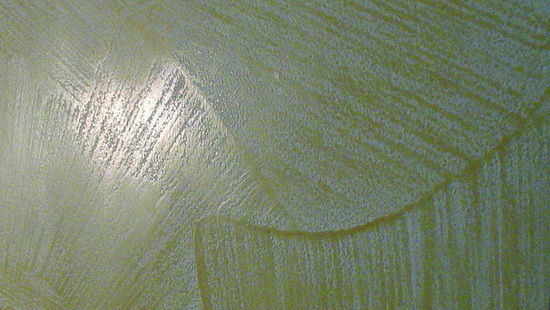
Conclusion
Painting not only changes the appearance of the building to a large extent.
Also, the facade is protected by paint from negative external influences, and its service life becomes longer.
The main thing is correct and how to apply it. Then you can not worry about the fact that the surface will look great and last for many years.
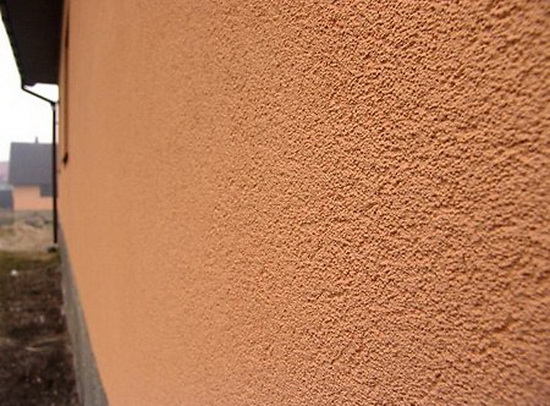
As you know, the facade is main part at home, and the impression about the building itself, and about its owner, is formed precisely after the first glance at the frontal part ...
By appearance facade panels for exterior finish are different. There is also a significant difference in cost. Many are attracted, for example, by reinforced plastic foam facade panels...
Man is so arranged that it is not enough for him just to have his own Vacation home or a cottage, a roof over his head, he also wants the design of his house ...
The renovation has come to an end. But the outer facade remained, so to speak, the face of the house. And often the question arises how to make it not only attractive, but also individual. In fact, options exterior finish a lot, one of them is textured paint for outdoor use. And it is necessary to dwell on it in more detail.
Facade paint is very different from the one used for interior work, because it is entrusted with the difficult task of resisting all the hardships and vagaries of nature, which is why it is so important to choose quality manufacturer and never save money. Facade paint should serve for many years and not lose its qualities.
Properties of facade paints

Home hallmark facade paint can be considered its unique throughput, it releases steam that accumulates on the walls of the house to the outside, while preventing moisture from penetrating inside. Not every manufacturer can boast of such quality.
Paints for outdoor use are distinguished by their external features on glossy and textured, and most often preference is given to the latter option, since with its help it is not easy to paint the facade of the house, but also to give it individuality.
A feature of textured coatings is that they contain solid particles, due to which various effects are created. Sometimes it can even be a small marble crumb. Therefore, you can make textured paint yourself, for this you just need to mix paint for facades, with decorative plaster but must be from the same manufacturer. This method was often used in the last century, but today it is much easier to buy ready-made paint that does not require additives and solvents.

Characteristics of facade paints
Of course, the decorative component is very important for exterior decoration, but this is not enough, the coating must also meet technical specifications. Such as:
- Resistance to external influences.
- Low flammability.
- Weather resistance.
- Absence harmful effects per person.
And profilux textured paint meets all of them, which is why it is popular among specialists. Thanks to the water-dispersion base and the acrylic polymer in the composition, this paint is ideal for both exterior and interior plasterboard work.
Important ! If the selected paint is fassadenfarbe, then the color must be of the same brand. Otherwise, you can lose everything unique properties coatings.

Many facade textured paints for outdoor use tend to fade over time, or take on a yellowish tint. This happens due to the use of low-quality polymers in the production, which lose their properties when exposed to an aggressive environment.
It is impossible not to mention another unique quality of textured paint for facades, namely its ability to hide all the flaws of the wall. Plastered or simply brick surfaces have a very unsightly appearance, and an uneven structure. Because of this, it is often necessary to level the surface before painting, but profilux textured paint, due to its consistency and composition, not only masks defects, but is also able to highlight them qualitatively, turning banal cracks into a craquelure effect.
Of course, the masking effect of facade textured paint is very important, but this does not mean that it can be applied to the surface without preparation. As mentioned above, the facade of the house is constantly exposed to environmental influences, which is why it is so important that not only the coating, but also the base be of high quality.
The use of impregnations and primers is necessary to protect the surface of the wall from the formation of fungus and mold. As a rule, they are colorless and dry in a few minutes, therefore they are not able to change the color of the paint or adversely affect its properties.
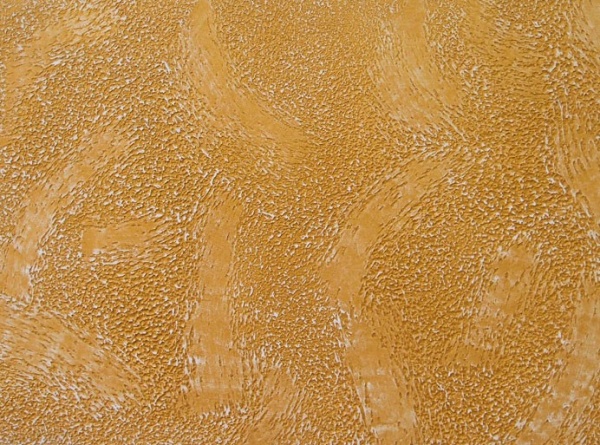
Advice ! If fassadenfarbe relief textured paint is used for painting, then the primer should also be of this brand, since they contain identical functional additives and ideally complement each other.
Methods for applying textured paints
Present on the market huge variety colors and textures of facade paints, and even if it was not possible to find exactly the color that you wanted, you can always use tinting paste. With its help, it is possible to create a unique shade that you will not find anywhere else.
Advice ! It is better to entrust the tinting of paint to a special machine that will remember the necessary proportions and be able to repeat the shade if necessary.
There are several ways to apply textured paint on the facade of a house, depending on what effect you want to achieve:
foam sponge
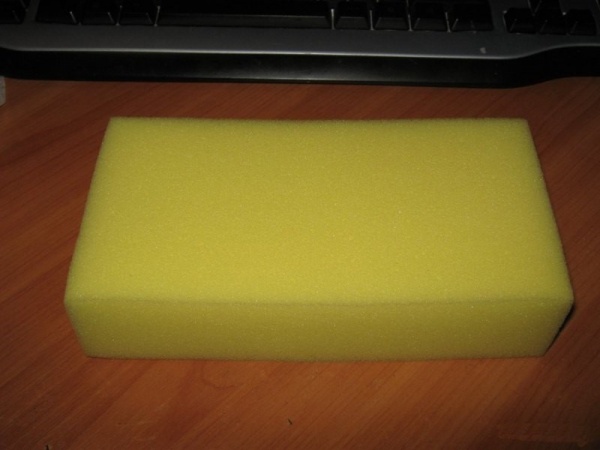
A foam sponge cannot, strictly speaking, be called a tool for applying paint, it rather acts as a tool for creating decorative effect. Therefore, first, the paint is applied with a roller or spray gun, allowing the top layer to seize (an average of 30 minutes) by blotting to create a “fur coat”. This is one of the most frequently used methods in the last century, but has not lost its relevance today.
Leveling trowel
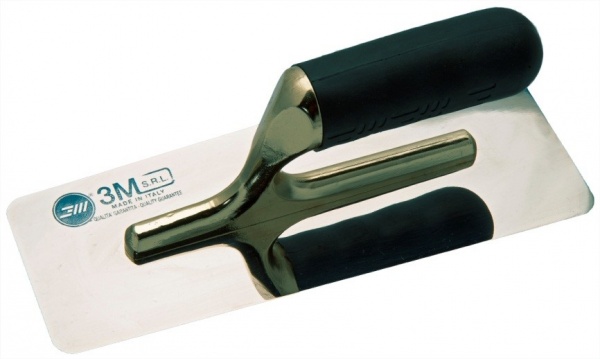
Mostly, this tool is used to level the plaster, but if you use different pressure and wave movements during work, you can get an imitation of the skin. Also, special nozzles with different configurations and textures are sold on the trowel. An alternative to this tool can be a regular metal spatula.
Textured roller
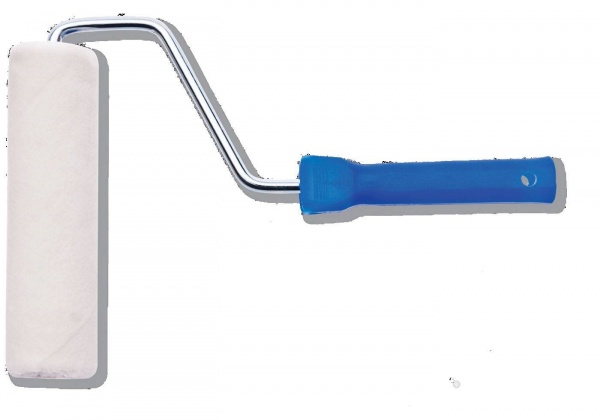
The easiest way and does not require special skills. With this method of painting, the coating layer is somewhat thicker, which is why many paints have a longer drying time, but if you use facade textured fassadenfarbe relief paint, you don’t have to worry about this problem, because thanks to the use of high-quality acrylic copolymer in the composition, the term complete drying is only 24 hours. And the hardening of the upper layer, 2-4 hours, with temperature conditions from +15 to +25 degrees.
The convenience of using the roller is that, depending on the design concept, you can use different “fur coats”, which can be made of foam rubber, fur, rubber or textured. Each "fur coat" creates its own effect and is even capable of applying simple decorative patterns.
The video shows how with a simple roller you can create a wide variety of effects using just one facade paint.
Applicator

This tool has a corrugated imitating surface that looks like tree bark. It is applied in the same way as a sponge, when dried top layer by pressing against the surface. This method is somewhat longer than others, but the drawing is also more difficult.
Important ! Using an applicator or a sponge, the walls need to be painted in stages, as you may not have time to apply the texture before drying.
Airbrush
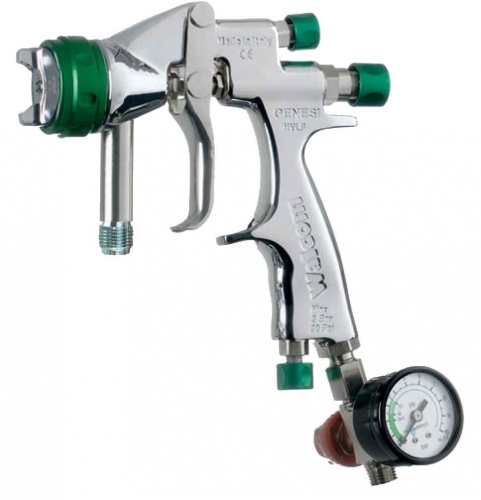
The application of textured facade paint by spraying, a process that requires certain skills and experience, since when different thickness layers may form streaks or gaps. The advantage of this method is that the paint consumption is significantly reduced. And if you need to cover large volumes, then this method is the fastest.
Important ! Protective equipment must be worn when working with sprayers to protect the eyes and Airways from paint ingress.
Knowing how to use the listed tools, you can not only achieve perfect coverage but also combine effects. This is often practiced when the facade of the house has a complex design form and it is necessary, for example, to highlight a cornice or a plinth.
Important ! If there is an old peeling coating on the wall, it must be removed with a spatula and sandpaper, otherwise the new coating will not connect to the wall surface, regardless of the quality of the facade paint itself.
Conclusion
In conclusion, it must be said that facade finishing is not only one of the most difficult stages in construction or repair, but also very costly. And, so that it doesn’t work out, as in the saying about the miser, it’s better to spend one time on quality materials than to restore and remodel every year. Paints, primers, and impregnations profilux have long established themselves both among homeowners and professionals.
Materials for outdoor decoration are distinguished by a variety of types and shapes. Recently, embossed coatings capable of gaining special popularity.
Working with such materials is somewhat more difficult than with ordinary ones, it requires a certain idea, the possession of skills for such work. But the result is worth the effort, as it creates an original, stylish surface with a non-standard look.
One of similar coatings is a textured facade paint, the use of which differs significantly from conventional technology application of external coatings. Let's consider it in more detail.
Textured paint is an external coating that creates a relief surface with different type pattern and volume. At the same time, the result is determined not only by the composition of the paint. The appearance of the coating largely depends on the method of application, as well as on the shape of the tool used.. A surface is created in which several properties are harmoniously combined - color, degree of gloss, type and size of the applied relief. There can be a great variety of possible combinations of these properties, which makes each use case original, unlike the others.
In order for the material to have such qualities, an unusual physical composition- high viscosity, the presence of various fillers (for example, ordinary river sand).
It is the fillers that make it possible to hold a certain shape, not to spread over the entire surface or not to drain to the ground. The height of the relief can be quite large, and the size of the filler grains determines the possibility this composition form a pattern of varying degrees of volume.

In addition, the application method itself allows you to create completely different types of textures from the same material. In this matter, there are a huge number of options - the size of the tool, the type of pattern, binding to geometric shapes or complete chaos - all methods are good in their own way and can be used, you only need to have the technique of applying textured paints.
Textured paints can be used on different types grounds:
- Drywall.
- Metal.
- Stone, etc.
In addition to decorative qualities, textured paints perform other functions inherent in exterior coatings:
- Protect walls from water penetration.
- Provides steam output.
- Exclude the occurrence of mold, fungus, etc.
In this way, structural paints are the same outer coverings, but with a deep decorative effect.
Types of textured facade paint
Textured paints differ in size and type of filler. It is he who makes it possible to create a certain structure of the paint layer, to imitate some natural textures.
For example, paint "bark beetle" imitates the surface of wood damaged by insects. The “fur coat” or “lamb” effects are also widespread, having a uniformly rough relief of various heights.
Outdoor use somewhat limits the possibilities of textured paints, as weather or atmospheric conditions intervene in the situation. We have to work as quickly as possible, so some types of coatings that are successfully implemented on internal surfaces, on the facade is impossible to execute.
Most often on today's market there are textured paints based on water-dispersion acrylic mixtures. They best combine performance, price and performance. However, some manufacturers are successfully making textured solvent-based paints using traditional materials time-tested. Almost all external coatings are certified, have all necessary qualities fully comply with the declared characteristics.
Features of textured facade paint
The use of textured paint for outdoor work has its own characteristics. For instance, relief surface does not require a perfectly flat base, shallow dents or other flaws will be masked by a specific coating pattern.
In this case, the paint layer is thicker than usual, which requires the use of special formulations to facilitate drying. In addition, textured facade paints have increased strength, resistance to abrasion, mechanical stress.
NOTE!
If necessary, textured paint can be done independently, for which it is necessary to mix facade paint with putty in the required proportion, add filler - sand, marble chips, etc. The main thing is that the materials are made in the same company, match each other.

Advantages and disadvantages
The advantages of textured paint are:
- The ability to form a unique surface pattern, embody any fantasy.
- In the presence of the old coating is not best quality you can mask surface flaws, hide cracks or potholes.
- A more durable coating layer than usual.
- High vapor permeability, moisture protective properties.
- High frost resistance.
- Coating durability.
However, there are some disadvantages:
- The need for application skills. The technology is simple, but it may not work the first time, so it is best to start from inconspicuous sections of the walls.
- High material consumption, which at the same time means high costs.
The advantages and disadvantages of textured paints are quite typical for many finishing materials and do not limit demand among consumers.
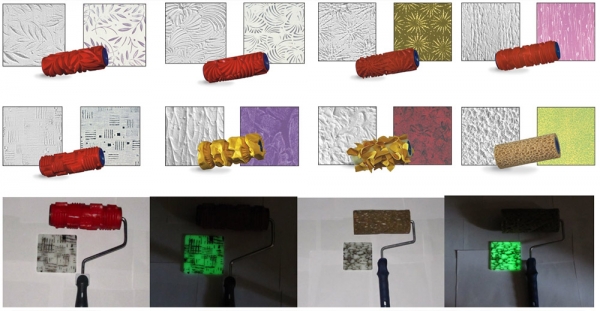
Application tool
For textured facade paints, a mechanical tool (spray gun) and different types are used. hand tools, which include:
- Rollers with different types skins.
- Spatulas rubber and metal, straight or serrated.
- Hard brushes with short pile.
The use of brushes is ineffective, since the brush is designed to smooth and evenly distribute the paint, and the specific texture compositions require the formation of a relief.
A grater is often used to form the “bark beetle” structure, which makes it possible to form grooves and stripes characteristic of this type of relief. You can also use a rubber or Teflon spatula.

Surface preparation
Before starting work, it is necessary to free the surface of the walls from all foreign attachments, fixtures, brackets, lanterns, etc. It is recommended to remove trim from window and door openings.
To apply textured paint, it is not necessary to have a perfectly flat surface.. If the flaws on it are small and deep, comparable to the height of the relief, then it is not necessary to make any preparation.
However, if there are delaminations or flaking of the surface, they should be removed, why with a spatula it is necessary to remove all problem areas. The resulting dents and irregularities should be plastered and a layer of deep penetration primer applied. A layer of plaster should be kept for at least a week to complete the crystallization processes and remove alkali from the composition.

Surfaces previously covered oil paints or enamels, should be cleaned of old layers and carefully primed.
Application technology
When using a spray gun (spray gun), a surface with a uniform roughness is obtained. In this way, it will not be possible to apply a specific pattern, but this method is optimal to reduce time and increase labor productivity.
Manual application of textured paints is done with one of the selected tools. The roller makes it possible to create a structure with fine relief(if the roller is smooth) or with a larger one (if a skin with a long pile is worn).

The use of a spatula makes it possible to create various geometric figures, repeated in different variations or sizes. At the same time, the presence on one wall a large number heterogeneous relief elements are visually perceived as a chaotic heap, sloppy work.
It should be remembered that any, even the most asymmetrical, pattern is subject to certain laws and must have some kind of logic or repeatability. Practice shows that not too complex figures look most impressive, having approximately equal area, not too large.
When choosing a pattern, you should constantly limit yourself so as not to overdo it with too intricate and sloppy elements.
The use of texture facade paints creates a full-fledged exterior coating that has high performance combined with an enhanced decorative effect. The complexity of application, increased paint consumption is fully justified by the result, which creates a stylish, original look of the facade of the house.
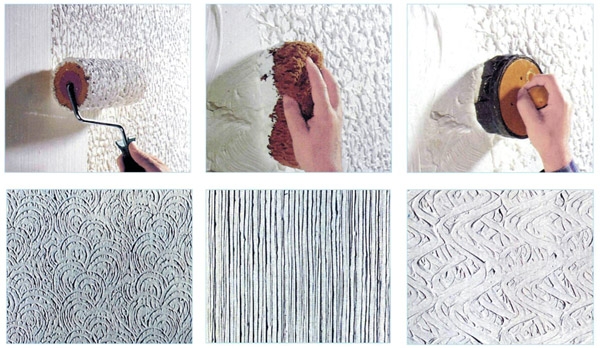
In the absence of skills in working with such materials, it is better to invite a specialist, or at least start working from the back walls, invisible from the street. In any case, the result will be a unique pattern that adorns the walls of your home.
Useful video
Applying textured paint with your own hands:
In contact with
Textured paints are special mixtures for surface treatment. building structures, which, in addition to the protective function, have pronounced decorative properties. With the help of these paints it is possible to give the surface a look that imitates natural materials- stone, leather, fabric, sand and others.
In addition to existing in nature and well-known textures, these paints make previously impossible and difficult-to-implement effects available to designers - combinations of uneven surfaces and various color transitions.
Textured paints consist of a binder and a filler. The filler is grains or granules of various minerals or artificially obtained substances - marble chips, quartz sand, polymeric materials.
It is the filler that allows you to achieve a decorative effect when using such paints. The binder and film-forming element of the paint is silicone, acrylic (polyacrylate) or silicate composition. For exterior paints, the basis is, in most cases, polyacrylate.
Depending on the resistance to atmospheric phenomena (precipitation, wind, changing temperature), textured paints are divided into facade, more resistant, which can be used for outdoor work, and paints for indoor use.
Pros and cons
What are the advantages and disadvantages of textured facade paints?
Here is a short list of the advantages of textured decorative coatings:
- due to the relatively thick layer of application and the presence of artificial irregularities - relief, paints visually hide minor defects surfaces, so the facade does not require careful alignment;
- all such paint materials are characterized by good vapor permeability, which has a positive effect on the state of building structures of the building - moisture does not accumulate in them;
- textured paints have increased resistance to external influences compared to other facade paints. This property increases the service life decorative coating several times;
- they can be applied to any surface - wood, concrete, plaster, metals;
- The light fastness of such paints is much higher than that of traditional ones. Even after a few years, the shades of the colors will be the same as when applied;
- number of texture options and possible patterns, combined with various color solutions almost infinite, which provides complete freedom of creativity for designers;
- they are easy to apply, to create a unique facade you do not need to have any special skills and abilities;
- they are easily tinted, mixed with various fillers and creative pastes, and pure water can be used for dilution;
- texture paints do not emit harmful substances, almost odorless even when applied, this is one of the most environmentally friendly materials;
- painted facade acquires additional protection from fire, as these paints do not support combustion.
But besides the advantages, there are a number of disadvantages:
- the main disadvantage is the high consumption during application, from 500 grams to one and a half kilograms, while ordinary water-dispersion or oil facade paints require no more than 200 grams per square meter;
- street dust is more easily retained in the irregularities of the decorative coating, so the facade requires periodic maintenance;
- this option for finishing the facade has a relatively high cost.
Usage Feedback
What do experts and ordinary homeowners say?
Analyzing the reviews of designers, builders and owners of private and commercial buildings who have chosen textured paints for facade decoration, we can draw an unambiguous conclusion - this type of coating is practical, durable and capable of giving absolute exclusivity to the appearance of the building.
The quality of coloring and decorativeness depends entirely on only two factors:
- the skills of the painter - finisher and the artistic taste of the designer;
- the quality of the paint itself, the ratio of the filler and the binder base.
What is the best and cheapest way to use textured paints?
The cost of a kilogram of textured facade paint from Russian manufacturer the average is 70-80 rubles, and materials from foreign brands - 150-180 rubles. These figures are not particularly different from similar prices for oil or water-dispersion paints for outdoor work. However, if we take into account that the consumption of textured coatings is 4-5 times higher, then the high cost of such facade decoration becomes obvious.
There are several tricks to save money when buying materials and working with this modern and original look finishes:
- buy paint white color. It is cheaper than already painted. This will allow in the future to buy inexpensive fillers and tinting compounds and spend them more economically. However, it should be remembered that it is necessary to add color and fillers immediately to the entire required amount of paint in order to avoid uneven coverage;
- when choosing a paint, pay attention to the composition. In high-quality paint, the proportion of the binder base is at least 15%, and the dry residue is not more than 50%. Cheap compositions are unstable and will require an early update, which, in the end, will make all the work more expensive;
- Ink consumption can be reduced by choosing a method of application that produces a smaller layer, such as using textured rollers with a shallow relief. The depth of the texture can subsequently be visually increased by applying a color tone to the protruding elements using a hard roller. An even and thin layer is easily achieved by applying paint with a construction trowel.
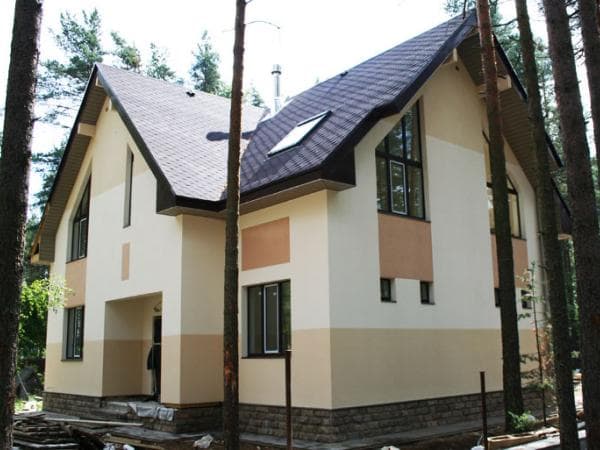
How to apply correctly?
The technology of applying paint and achieving decorative effects involves the following set of tools and accessories:
- construction mixer or electric drill with a mixing nozzle;
- compressor and atomizer with nozzles of large diameters;
- construction trowel and spatulas different sizes, including with a jagged edge;
- rollers for texturing or applying a three-dimensional pattern.
You can experiment with materials that are right at hand. For example, wrap a rubber roller with a linen cord or a thick rope - when applied, a texture is obtained that resembles reed or bamboo stalks.
A reel of masking tape (adhesive tape) can serve to separate surfaces with different color and texture shades.
All painting work can be divided into stages:
- surface preparation step. The façade needs to be seen. If, according to the results of the inspection, it is found that the surface is fragile, crumbles or exfoliates, then such fragments are removed and partial plastering is carried out. In this case, careful alignment can not be carried out. The surface is cleaned of dust and dirt, should not have areas with mold or fungus.
- next technological operation a primer should become - this will increase the adhesion of the paint layer to the facade surface;
- stage of paint preparation. At this stage, the paint is mixed, tinting compounds, creative pastes or additional fillers are added to it. During this operation, it must be remembered - to obtain a greater smoothness of the surface, you can add water, but not more than 10% of the paint volume. To obtain the effect of greater roughness, washed paint can be added to the mass of paint. quartz sand, also not more than 5-10%. For building facades, it is preferable to use muted, pastel color tones. The mixture is best mixed with construction mixer or drills with a nozzle;
- The next step is applying the base. This work is carried out using a pneumatic sprayer or manually - with a spatula or trowel. The purpose of the operation is to create a working layer of paint on the surface of the facade. The thickness of the layer depends on how deep the texture needs to be obtained.
There are nuances: the diameter of the spray nozzle must be at least 3 mm, and the air temperature during the work should not be below 5 and above 30 degrees above zero. Work is not carried out in rainy weather. It is advisable to cover one side of the wall or a certain area in one cycle in order to avoid cracking.
The operating procedure of the sprayer is as follows: a thoroughly mixed coloring composition, then from a distance of 40-50 cm, the first layer is applied with smooth movements parallel to the ground. At large areas facade walls should be painted faster, preventing the mixture from solidifying.
After applying the first layer, the second is sprayed, jets across the first. It is desirable to cover the borders of the sections of the first with a second layer. To work with this method, the composition of the paint is made more liquid by adding water. How much water is needed is determined empirically, diluting a little and trying the sprayer.
For application with a construction trowel or spatula, the consistency of the paint should be thick, resembling putty. A portion of the paint is superimposed on working part trowel with a spatula, then, like putty, the mixture is applied to the wall and distributed with a few leveling movements in an even layer. It is necessary to ensure that in the end there are no unpainted areas.
Tip: even when applying paint, you can achieve the simplest decorative effect if you use a trowel or spatula small size and make deliberately rough strokes.
Decoration stage
An invoice or three-dimensional drawing can be created different ways, the main ones are the use of special rollers with a patterned surface, drawing with notched or smooth spatulas. The artistic effect is limited only by the artist's imagination.
Rollers should be worked from the bottom up, slowly, rolling in even stripes. A beautiful texture with a pattern is obtained when working in a circular motion with notched trowels.
To speed up the work, it is advisable to work with two performers. The first applies the foundation, the second immediately decorates.
When applying several layers, each layer must be allowed to dry completely for about 12 hours. Each layer can be painted in its own color or have a different filler.
Of course, covering the facades of buildings with textured paint is not an easy way. final finishing, but it is this approach that makes each house unique and inimitable, unlike others and reflects the artistic taste of the owner.
Finishing the facade of the house is a very responsible and important process. The fact is that it is necessary not only to give the surface a good appearance, but also to provide it with protection from external influences.
That is why textured facade paint is very much appreciated among contemporary masters because it combines both of these qualities.
Properties and varieties
To begin with, it is necessary to say that there is great amount similar materials, which differ from each other not only in their properties, but also in the application technology. At the same time, very often textured paint for facades needs special tools, which allow you to create a certain relief.
With this in mind, it is necessary to select all the materials necessary for work, even at the design design stage.

Specifications
- First of all, it should be noted that these compositions must be highly resistant to moisture. Wherein professional craftsmen It is recommended to use just such materials that are not afraid of even direct contact with water.

- Also, the facade dye must tolerate temperature changes and direct exposure well. sun rays. For comparison, you can take Polystil fire-retardant paints for metal, which not only cope well with heating, but also do not lose their shade.
- It should be mentioned that in order to obtain such characteristics, quite often they use quite toxic substances. That is why professionals advise to carry out all work using individual means protection or try to find materials with a higher environmental component.

- It is important to mention that the data is very dense and requires a specific application technique. Usually it is described in detail by the installation instructions that are attached to a specific product.
- It is worth saying that such dyes have good color saturation and when stained relief wall they create a uniform layer that does not stand out even in areas with large drops. That is why they are often used for relief plaster or added directly to the mixture.
Advice!
All materials intended for are usually marked specifically, indicating this on the packaging.
This is especially true for paints, since the requirements for their choice are very serious.

Application features
- It is worth noting that the price of such materials is quite high, so it is necessary to clearly understand the technology of their use in order to reduce consumption and reduce losses from the incompetence of performers. To do this, it is very important to study the instruction manual in detail and familiarize yourself with other materials at hand.
- First of all, it should be noted that in order to create a certain texture, special substances are often added to the composition of such dyes. In this case, it is enough just to apply the mixture to the surface so that these components begin to work, creating a relief. Zinga conductive paint was created on the same principle, which is simply used to create the necessary layer.

- There are also types of materials that need an additional tool. For example, quite often professional craftsmen use paint rollers with a certain relief that contributes to the creation of texture.

- Special attention deserves special additives, and dyes that allow you to influence the layer formed. They are added to the composition of the dye with their own hands, determining the intensity of the location at their discretion. Such materials are very common in recent times and have a lot of varieties. (See also the article.)
Advice!
Surfaces that combine several application technologies look pretty good, especially if a different color is used.
However, before making such decisions, it is necessary to create a sketch appearance to get an idea of the end result.

Conclusion
After watching the video in this article, you can get more detailed information about what paints exist for facade works and how they are used. Also, based on the text presented above, it should be concluded that the choice of this type materials must be approached very responsibly, taking into account not only special properties but also the appearance.

